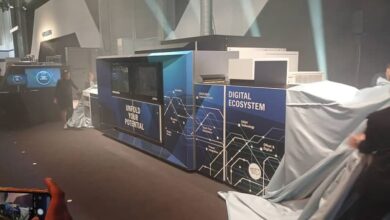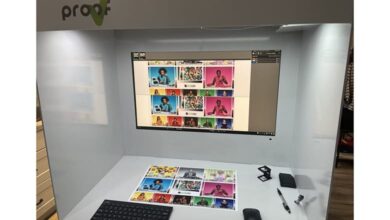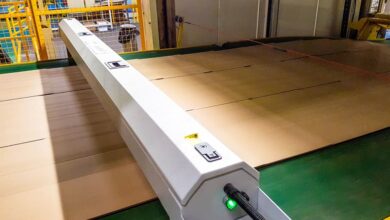A Very Good Option For Sheetfed Printers
Jan-Philippe Fournier, Sales Manager of IST METZ GmbH for Sheetfed Applications recently travelled to Dubai and we had opportunity to sit down with him and discuss about LE UV technology in detail.
Why do you think UV is becoming attractive to commercial printers? Surely the extra financial costs of ink, the difficulty of flexible working e.g. changing a press’ printing order because of variable colour coverage from job to job, washing up etc. at short notice, the health and safety issues both in handling and environmental and atmospheric precautions required are real draw backs – all for benefit of faster turnaround of the printed job?
UV has so far discovered a dedicated market. In a nutshell UV is favorite if it comes to fast turnaround, protective functions, inline production and high quality products.
For example if LE, UV is used then there is no need for protective coating, special handling i.e. for perfecting machines and therefore it leads to lower investment. On the other hand LE could also bring higher quality i.e. due to inline coating or less penetration into absorbent paper. LE UV is an option for conventional printers, but not a must have.
Can the lamps be retrofitted to an existing press? Is there a press age or model where it would be not worth it?
A retrofit for the end of press is easier, as long as there is available space. Most probably machines out from the year 2000 will have UV prepared grippers.
Most commercial jobs have variable ink weights. Can data from CTP be used to calculate the speed of throughput when using UV LE?
Typical LE UV inks are designed to cure with 1 lamp at maximum printing speed – Pre press is similar to conventional printing. You should respect the methods for ink reduction – or even more due to ink costs.
Are any of the process UV inks require more attention, e.g. conventional Magenta can be trickier with tack issues etc.?
Process inks are set up to be printed in the standard sequence B, C, M, Y. This means the tackiness is adjusted to this sequence.
Why not when changing over to UV LE put in at least two banks of lamps, one after the first two colours and the second after printing and then use one or both as optional choices depending on the job?
Could be done, we are pleased to deliver 2 or 3 lamps. This is a question how much money printers want to invest. You should also consider that the installation of an interdeck is more complex.
The extra cost would make less need for changing the running order of colours and lessen the effect of contamination of the yellow?
Never forget that conventional printing machines will also print wet-on-wet and will have therefore similar problems.
What would a Dubai commercial printer have to be specifically aware and concerned with, particularly at a staffing level when considering investing in a UV LE equipped press? The regulations in Europe are very stringent on these matters.
LE is also UV equipment. This means UV safety aspects have to be respected and are provided by ink (SDS) and hardware manufacturer (manual).
The toxicity of UV inks and chemicals is well known do you offer an education service with new installation?
This important item has to be handled by ink manufacturers as well. Product safety data sheets will transfer already a lot of necessary information. From IST side we do offer UV trainings which will also handle safety.
What training is available to ensure a printer and a job estimator gains a comprehensive knowledge on optimum speeds and lamps strengths can be used on a particular job. Can software be added to workflow CTP programmes to help with this issue?
Typically the system is set to maximum power as a startup. More experienced printers (while gaining experience) know that power reduction can be used, but typically this is not done.
Experience suggests that the percentage of jobs that go wrong when running UV is much higher than when running a normal commercial job with conventional inks. Blanket and roller deterioration is an important contributor. What do you think?
Every new technology brings along new conditions. Staying in tradition will prevent people from discovering new market opportunities.
Are the support facilities in UAE, other than from Heidelberg, particularly with blankets, rollers and inks competitive and to a high standard to ensure a printer investing has a choice and gets a fair deal?
A lot of consumables do already exist due to the standard UV business. Ink and coating has got an important role. Nearly every ink manufacturer has got now dedicated ink.
The return on investment (ROI) for any printer will be of concern. It could be suggested that in a five year period a printer would struggle to make an effective ROI investing in UV whether LE or standard. What are the comparative threshold of performance or run lengths you would expect a printer to achieve to warrant making an L E Investment? This can be a broad brush answer for there is a chance a printer could win new business with UV, but I doubt it because the finished job has a duller more matt finish, spot colours, particularly metallics can present issues and these factors will add additional press passes to overcome.
This is always a question how you compare. A printer who is doing 4C conventional in 1 shift may not be interested, but doing 2 shifts with the need for coating for fast processing is different. This printer could eliminate a coating tower, the IR dryer, the coating and may be spray powder as well. As already said LE is not a technology for everybody.
And regarding the second part of your question you should understand that there are also higher glossy inks on the market. Another alternative is a coating out from ink duct.
Use of water coolers to cool conventional UV is a high energy solution, more so than sealers and infra-red, does UV LE help to be more competitive and if so in what ways?
Our CD 102 is using roughly 100 kW for IR and hot air. LE is only using 21 kW for a single lamp.
Read More: Taking The Mystery Out Of UV-LE Technology
 Up until now UV applications have primarily been the domain of packaging printers and specialists.
Up until now UV applications have primarily been the domain of packaging printers and specialists.
In the current market, when short lead times increasingly bring competitive advantages, UV is becoming an attractive proposition for commercial printers, too.





